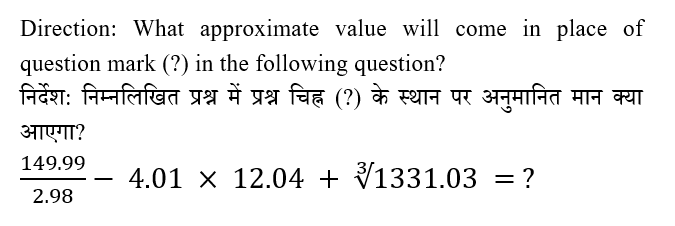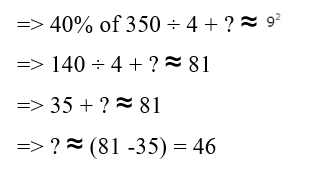Question 1:
An amount of ₹4500 becomes ₹6300 after 2 years at R% rate of simple interest. Find the compound interest received on that sum after 2 years at R% rate?
₹4500 की धनराशि 2 वर्ष बाद साधारण ब्याज की R% दर से ₹6300 हो जाती है। 2 वर्ष बाद R% की दर से उस धनराशि पर प्राप्त चक्रवृद्धि ब्याज ज्ञात कीजिए?
Question 2:
A shopkeeper mixes two varieties of rice worth Rs.50/kg and Rs.90/kg to form a mixture of 728 kg. If the cost of mixture is Rs.75, then what is the quantity of rice worth Rs.50/kg in the mixture?
एक दुकानदार 728 किलोग्राम का एक मिश्रण बनाने के लिए 50 रुपये/किलोग्राम और 90 रुपये/किलोग्राम चावल की दो किस्मों को मिलाता है। यदि मिश्रण का क्रय मूल्य 75 रुपये है, तो मिश्रण में 50 रुपये/किलोग्राम चावल की मात्रा कितनी है?
Question 3:
The speed of current is 5 km/h. Downstream speed of a boat is what percent of the Upstream speed of the boat, if ratio of the time taken to cover a certain distance 'd' going downstream to the time taken to cover (1/3) of the distance 'd' going upstream is 1:1.
धारा की चाल 5 km/h है। यदि एक नाव द्वारा धारा के अनुकूल एक निश्चित दूरी 'd' को तय करने में लिए गए समय और धारा के प्रतिकूल दूरी 'd' के (1/3) भाग को तय करने में लिए गए समय का अनुपात 1:1 है, तो धारा के अनुकूल नाव की चाल, धारा के प्रतिकूल नाव की चाल का कितना प्रतिशत है?
Question 4:
Alok and Ram start a business with investments of Rs.6400 and Rs.9600 respectively. After 4 months from the start of the business, Ram quits and re-joins the business with the same investment 4 months before the end of the year. Find the ratio of the profit shares of Alok and Ram respectively in the total annual profit.
आलोक और राम क्रमशः रु.6400 और रु.9600 के निवेश के साथ एक व्यवसाय शुरू करते हैं। व्यवसाय शुरू होने के 4 महीनों के बाद राम व्यवसाय छोड़ देता है और वर्ष के अंत से 4 महीने पहले समान निवेश के साथ पुनः व्यवसाय में शामिल हो जाता है। कुल वार्षिक लाभ में से क्रमशः आलोक और राम के लाभांशों का अनुपात ज्ञात कीजिए।
Question 5:
An article is sold at 20% percent profit. If it was sold at Rs 330, there would have been a percentage loss of 25%. At what profit was it actually sold at?
एक वस्तु को 20% के लाभ पर बेचा जाता है। यदि इसको 330 रुपये में बेचा जाता तो 25% की हानि होती है। वास्तव में यह कितने लाभ पर बेचा गया था?
Question 6:
Direction: What approximate value will come in place of question mark (?) in the following question?
निर्देश: निम्नलिखित प्रश्न में प्रश्न चिह्न (?) के स्थान पर अनुमानित मान क्या आएगा?
? % of 525.03 ÷ 7 + 159.95 = 190
Question 7: 
Question 8: 
Question 9: 
Question 10:
A shopkeeper marked up some percentage above its cost price and give 25% discount while selling, then he earns 30% of profit. If he gets Rs. 90 as profit, then what is discount given by him?
एक दुकानदार ने अपने क्रय मूल्य से कुछ प्रतिशत अधिक पर अंकित किया और बेचने के दौरान 25% छूट दी, फिर वह 30% का लाभ अर्जित करता है। यदि उसे लाभ के रूप में 90 रुपये प्राप्त होता है, तो उसके द्वारा दी गई छूट कितनी है?




